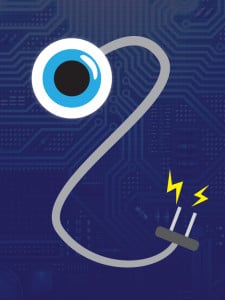Researchers at the School of Medicine have invented a light-powered retinal implant — or bionic eye — that may someday restore sight to those blinded through certain degenerative eye diseases.

According to a recent study in the journal Nature Photonics, the treatment, which stimulates visual neurons with high resolution, could restore sight for people suffering from retinal pigmentosa and age-related macular degeneration, with only minimal surgery.
The implant combines infrared video-projection goggles with a small photovoltaic chip implanted inside the retina to replicate normal eyesight. Images from a miniature camera mounted on the goggles are processed and projected onto the goggles’ screen, before laser pulses of near-infrared light beam the images to the chip’s photoreceptors.
Researchers had to overcome the obstacle of determining how to deliver a lot of light without causing pain for the user.
“If we used visible light, it would be painfully bright,” said Daniel Palanker, professor of ophthalmology and the study’s senior author. “Near-infrared light isn’t visible to the naked eye, though it is visible to the diodes that are implanted as part of this prosthetic system.”
The research team initially tested the photodiode arrays on rat retinas in vitro, allowing the team to demonstrate that the photodiodes could convert visual images to electrical signals in a situation similar to that induced by degenerative eye diseases. Those signals would in turn be transmitted to the brain via retinal neurons.
“The photoreceptor cells are dead and gone; all that is left are the (light-insensitive) signal processing neurons,” wrote James Loudin Ph.D. ‘11 P.D. ‘11, the study’s co-first author, in an email to The Daily. “Without something that electrically stimulates them (which is our photodiode array), they will simply not see any light of ANY frequency.”
Loudin emphasized the number of technological obstacles to developing the electrical system, including “fabrication processes that had never been tried before, data analysis techniques for hundreds of gigabytes of data, infrared projection systems 1,000 times brighter than had ever been tried.”
Retinal implants have been successfully trialed in the U.K., with two men who were completely blind subsequently able to perceive light and some shapes.
However, Stanford researchers asserted that compared to other retinal prostheses requiring a battery connected to the implant, the Stanford device’s use of near-infrared light and lack of large power-consuming hardware makes surgically implanting and then maintaining the chip more straightforward.
“The surgeon needs only to create a small pocket beneath the retina and then slip the photovoltaic cells inside it,” Palanker said.
Utilizing photovoltaic cells on the retinal implant would also allow the insertion of multiple arrays selectively positioned to create a wider field of vision at a higher resolution than comparable implants, according to researchers.
As development continues, however, researchers have begun testing the effect of implants on live rats, analyzing electrical spikes to measure whether light perception has changed.
“We recorded the response of their retinal ganglion cells (RGCs) to our stimulation. When successfully stimulated, a RGC will cause an electrical ‘spike.’ The strongest response is thus the one that produces the most spikes,” Loudin wrote.
Thus far, researchers have determined that the implant’s visual signals are successfully transmitted to the brain in blind and normal rats alike. However, human trials remain an ultimate, if distant, ambition.